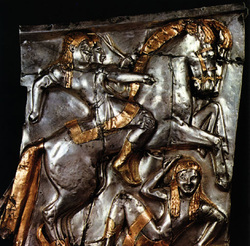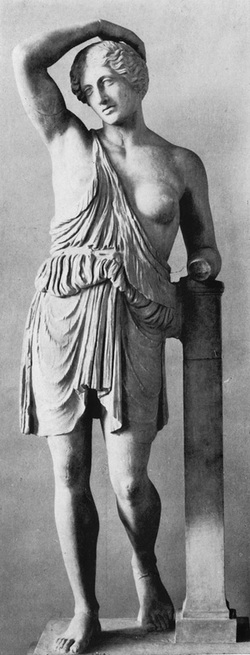The Amazonians were real; they were based off of real warrior women. Amazonia was real; it was based off of matristic, gynocratic nations.

The concept of the female warrior is a reoccurring theme in folklore, film and novellas. The infatuation with the Greco-Roman Amazonian archetype of the women warrior, has had historians spellbound and the histories of the matristic, gynocratic nation of Amazonia has both baffled and fascinated. Though there is growing evidence of the existence of multiple nations that had a socio-cultural matriarchal construct or had women with high socioeconomic and religiopolitical status. However, there is still many question regarding the detailed life of the warrior women.
Records of warrior women can be found on a global scale. Slavic, Celtic culture did not deny women any opportunity to not participate and engage in warfare, as did the Africans and the societal norms of Asia Minor. Though Athenian women were not granted permission to be taught in any area of academics, Spartiate women were literate, combative and were involved in state affairs. The high rank of Albanian women made it acceptable and a normality for them to involve themselves in militeresque pursuits. In fact, the lifestyle of Albanian, Turanian, Scythian and Sarmation women, largely resemble the Amazonia myth and the Amazonian prototype. To the point in which, it is believed by some theologians that these are the nations and peoples which the Greek based their generic myth of warrior women “Amazons,” off of.
Records of warrior women can be found on a global scale. Slavic, Celtic culture did not deny women any opportunity to not participate and engage in warfare, as did the Africans and the societal norms of Asia Minor. Though Athenian women were not granted permission to be taught in any area of academics, Spartiate women were literate, combative and were involved in state affairs. The high rank of Albanian women made it acceptable and a normality for them to involve themselves in militeresque pursuits. In fact, the lifestyle of Albanian, Turanian, Scythian and Sarmation women, largely resemble the Amazonia myth and the Amazonian prototype. To the point in which, it is believed by some theologians that these are the nations and peoples which the Greek based their generic myth of warrior women “Amazons,” off of.
The Greco-Roman Amazonian Histories.

Mind you, the term "Amazon," is a generic term to sum up the archetype of the "warrior women." That is why the usage of the term, on a historical level, is multi-cultural and is recognizable on a universal scale. The ideal imagery of the "warrior women," is that starred in Greco-Roman mythology and is often referenced back to as "Amazon," because of her international popularity. In the modern world, the Amazon is any physically and/or intellectually powerful or 'superior' women (a woman of superior strength and/or intellect), as well as a woman skilled in battle. In Greek mythology, the Amazons were exceedingly war-like and worshipped the Moon-goddess and Earth-mother in their violent aspects (such as the Maenads, who were grotesquely violent priestesses). Several Greek accounts deal with encounters between Grecian warriors and the Amazons. The symbolic power of these stories has never been adequately interpreted, as one would think the ability of invulnerable demi-gods and supermen such as Achilles or Heracles would be poor evidence of valor.
However, the ancient world still lived in the emotional and cultural shadow of a far earlier age of government structures approaching matriarchy. So, the actual ramification and impact of stories of Amazon defeat was that these myths would uphold the propriety of patriarchal ascendancy. The greater part of Greek Amazonian tales do not regard victories; as in the case of tales that recount wars between factions of Gorgons; the founding of Amazonia by the lawgiver Lysippe; the slaying of the King of Troy by Egee; the numerous conquests of Marpesia among the Thermodontines; tales of the sister-conquistadors Myrene and Mitylene among the Gorgons; and the founding of numerous cities, such as Clete's Italian colony.
Many superficial texts are even today, fond of repeating the false statements that all Amazonian myths are about Greek victories. For today only, the tales of Hippolyte's stolen girdle, the kidnapping of Antiope and the death of Penthesilea are popularly retold. Yet, the great majority of Amazon tales regard the successes of their champions and the expansion of Amazon influence. After a period of no less than 300 years, the empire began to decay and only then were Greek incursions effective.
The Greeks were keenly aware of several Amazon cult centers, notably in North Africa and the Mid-east. Awareness of these women was by no means limited to the Greeks, as they earlier influenced the Hittites; the 'hieroduli' were notoriously warlike priestesses among them. Graves of priestesses in Sarmatian cemeteries have been found to influence their armor and weapons, marked quite uniquely, with even more ancient symbols of the Scythians, indicating the far greater antiquity of their warring faith.
In Indic myths, they were called 'rhackshasis,' ruled by Rani Paraminta, worshipping the warlike Moon-goddess Uma. Chinese myth tells of 'the Woman's Kingdom,' their rich and unapproachable capital existing near a distant sea, possibly referring to the same Themiscrya in Amazonia, located on the Euxine. The Valkyries represent the northern branch of the cult.
Africa, Europe and Asia were each aware of the Amazons. Sharing a vast collection of "warrior women," mythologies intertwined with factual, historical occurences. Documentation of warrior women go as late as into the 1900s where African Amazons (also know as: "The Black Women of Sparta") are concerned.
However, the ancient world still lived in the emotional and cultural shadow of a far earlier age of government structures approaching matriarchy. So, the actual ramification and impact of stories of Amazon defeat was that these myths would uphold the propriety of patriarchal ascendancy. The greater part of Greek Amazonian tales do not regard victories; as in the case of tales that recount wars between factions of Gorgons; the founding of Amazonia by the lawgiver Lysippe; the slaying of the King of Troy by Egee; the numerous conquests of Marpesia among the Thermodontines; tales of the sister-conquistadors Myrene and Mitylene among the Gorgons; and the founding of numerous cities, such as Clete's Italian colony.
Many superficial texts are even today, fond of repeating the false statements that all Amazonian myths are about Greek victories. For today only, the tales of Hippolyte's stolen girdle, the kidnapping of Antiope and the death of Penthesilea are popularly retold. Yet, the great majority of Amazon tales regard the successes of their champions and the expansion of Amazon influence. After a period of no less than 300 years, the empire began to decay and only then were Greek incursions effective.
The Greeks were keenly aware of several Amazon cult centers, notably in North Africa and the Mid-east. Awareness of these women was by no means limited to the Greeks, as they earlier influenced the Hittites; the 'hieroduli' were notoriously warlike priestesses among them. Graves of priestesses in Sarmatian cemeteries have been found to influence their armor and weapons, marked quite uniquely, with even more ancient symbols of the Scythians, indicating the far greater antiquity of their warring faith.
In Indic myths, they were called 'rhackshasis,' ruled by Rani Paraminta, worshipping the warlike Moon-goddess Uma. Chinese myth tells of 'the Woman's Kingdom,' their rich and unapproachable capital existing near a distant sea, possibly referring to the same Themiscrya in Amazonia, located on the Euxine. The Valkyries represent the northern branch of the cult.
Africa, Europe and Asia were each aware of the Amazons. Sharing a vast collection of "warrior women," mythologies intertwined with factual, historical occurences. Documentation of warrior women go as late as into the 1900s where African Amazons (also know as: "The Black Women of Sparta") are concerned.
